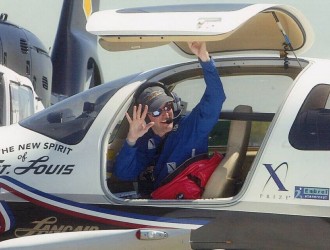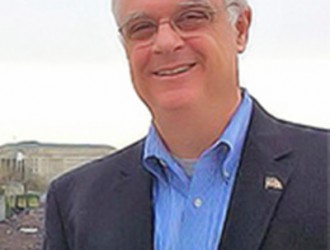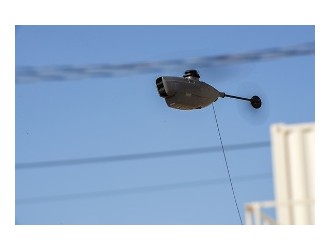This article was originally published in the May/June 1975 issue of R&WI and has been edited to comply with current grammar and style guidelines. Check out our special June 2017 50th anniversary edition of the magazine, wher we celebrate the past 50 years — and look ahead to the next 50 years — of rotorcraft innovations.
Used to be, you could call ahead on your way to Stratford, Connecticut, to be sure everyone would be there when you arrived. Not so these days, for Sikorsky maintains what some industry observers feel is the highest profile in the industry.

This time, we barely managed to catch anyone at home. Division President Gerald J. Tobias was in Rome, barely overlapping with Division VP for Commercial Robert F. Daniell, who was just returning from Europe. Commercial Marketing Manager Stephen Percy was in South America completing a round-the-world tour generating sales.
So who turned Sikorsky on? Most bets are on the 48-year-old president of the fre world’s oldest helicopter marker.
“Without his background and leadership,” Daniell said, “we would not have made the tremendous strides we have this past year.”
Tobias himself has taken to touring the Stratford facilities when not abroad talking with employees throughout the plant.
While Rotor & Wing interviewed Sikorsky management, business continued its stay pace. Evergreen Helicopters, of McMinnville, Oregon, was taking delivery of another S-64 Skycrane and a twin-turbine S-58T, while Helikopter Services of Norway was picking up an amphibious s-61N.
With the military market no longer what it used to be, Sikorsky is turning its vast expertise toward the commercial market. Drawing on a technological base developed over the years, the firm has now added a strong marketing base that is recognizing existing opportunities.
Realizing the need for frontal advance on the changing marketing scene, Sikorsky spawned a new commercial organization within the firm. Restructuring came at the hands of Tobias almost immediately after he came aboard in January 1974, selecing Daniell to head the internal organization. Under Daniell, Sikorsky sports a commercially oriented structure, completed with separate program managers, engineering teams, product and service support, and commercial marketing departments.
Tobias provided the major thrust for the overall international arena, spending most of his time abroad, looking for possible opportunities to sell equipment. Sikorsky is not ready to determine, and act on, whatever format might be required to sell machinery in any country. Of particular concern are the underdeveloped nations wher helicopters are prime assets.
Although the word to expand commercial business came down fro United Aircraft, Sikorsky’s corporate parent, Tobias was the man seleced to implement it. The helicopter industry had matured sufficiently and Sikorsky intended to remain a part of it. The firm had already expanded commercial business earlier with its popular Skycranes and S-61 series, marketed heavily in the ‘60s. Introducing the twin-turbine S-58T in response to operators’ requests had substantially renewed the firm’s contact with the commercial world.
Without slacking off on military projects and commitments, Sikorsky turned to expanding its product line. Organizational changes came first, separating the military fro commercial, with Daniell at the helm of commercial systems. Then came mapping out product line expansion and implementation. The expansion program itself developed along a three-point front.
First was refining military projects to suit commercial needs wherver practical. The YUH-60A utility tactical transport aircraft system (UTTAS) was at the top of the list, with the possibility of its civil version, the S-70C series, eventually replacing an S-61 fleet operating worldwide. Currently the ship prepares for a flyoff competition with Boeing Vertol’s YUH-61A alter this year. The winner takes a U.S. Army contract. Commercial operators are already showing considerable enthusiasm. Early commercial entry is being slowed, however, by the lack of certificated General Electric GE-T-700 engines. Engines pending, availability of the S-70s for operators is still expected for 1978.
The second major front is the S-65, being developed to meet the needs of commercial operators as a derivative of the military CH-53D series. Presently Sikorsky is defining exact needs of the market to determine if the S-65 has sufficient customer demand.
“The ground work is being laid now,” explained Daniell, “for three markets with the S-65: airline work in densely populated areas; heavy lift and utility; and the longer range offshore requirements that we see for the near future.”
The final front for the expansion program is the S-76, unveiled quite dramatically at HAA’s 27th annual convention in January. Designed to complete the firm’s full product line, it fills the gap in the “smaller than the S-58” size range. Extensive studies involving operators were made to determine future needs The resultant S-76 is reportedly the smallest planned size for Sikorsky’s product line. When setting out to find the ideal combination, twin-engine reliability with IFR capability was mandatory. Sikorsky felt the size range is ideal for the prime market it’s after, and Daniell explained that the firm is ”not really interested in the small, light helicopter.”
Tobias was emphatic when referring to the S-76.
“It’s not a derivative aircraft in any sense of the word,” he explained. “Its development is a direct result of studying the needs of the commercial marketplace and applying the most advanced technology at our disposal to the challenge of coming up with precisely the right aircraft for the times.”
Late February, Sikorsky set up a three-day special exhibit in Arlington, Virginia, to introduce the S-76 to the international and government community. However, the ship is funded as a pure commercial venture and was in no way subsidized by government contract.
“Very few, if any, truly successful commercial helicopter programs have been undertaken wher the program at some point in time did not receive some support from the military,” pointed out Daniell.
Pleased with consumer reaction to the S-76, he was quick to add that high interest among commercial operators reinforced Sikorsky’s belief that the machine will be one of these selec few, This interest was immediate at the HAA show unveiling, when Petroleum Helicopters Inc. President Robert L. Suggs announced PHI’s intention to order 10 S-76s, with options for 10 additional ships.
Not unlike the speed with which the original Sikorsky VS-300 was conceived, built, and flown in the late 1930s, the S-76 made such a sudden entry into the market that few people were aware it was on its way. Sikorsky had been entertaining the concept of introducing a smaller craft in its line; it just wasn’t talking about it. Early 1974 found the firm looking very loosely at the lighter twins on the drawing boards of foreign manufacturers, comparing the Aerospatiale SA-365, Agusta A109 Hirundo and Westland Lynx. However, none seemed to fit the pattern of needs that Sikorsky saw, and the decision was made to introduce its own design.
Just prior to decisions to produce the S-76, Sikorsky had examined the A109 Hirundo at great length, contemplating licensing to build and market the Italian light twin in the U.S. When queried about the role the A109 had in the decision, Daniell was explicit:
“We examine the Agusta A109 in quite a bit of detail but felt that it would not be good for either Agusta or Sikorsky,” he said. Explaining the firm’s philosophy, he added, “In our analysis, if a second engine is added to the helicopter, there is a substantial cost increase in both initial acquisition and direct operating cost. You have to pay for it with productivity — either passengers or cargo. We felt the Agusta A109 does not satisfy the marketing structure and goals of Sikorsky. We were looking for a higher payload machine and finally decided we would have to build it ourselves.”
Future trends at Sikorsky include one of the most exciting developments in the industry: the S-69 advancing blade concept (ABC), which may well become the most sought-after compound aircraft on the market in the not-too-distant future Counter-rotating main rotors have provided the initial key to solving the problem of retreating blade stall permitting entry of a pure helicopter past the 300-mph mark. It may bring speeds as high as 350 kts.
Sikorsky Sees minor modifications of the ABC to make it a highly competitive machine for the short-to-medium-range world of corporate, commuter and feeder airline use.
“We are not firmly committed to commercial development of the ABC,” hinted Daniell, “but we are looking at it with twin jets mounted for auxiliary forward thrust.”
So wher is Sikorsky taking us this time?





